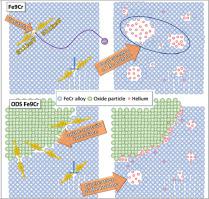Journal of Materials Science & Technology ( IF 11.2 ) Pub Date : 2021-09-16 , DOI: 10.1016/j.jmst.2021.08.004 Vladimir Krsjak 1, 2 , Tielong Shen 3 , Jarmila Degmova 1, 2 , Stanislav Sojak 1, 2 , Erik Korpas 1 , Pavol Noga 2 , Werner Egger 4 , Bingsheng Li 5 , Vladimir Slugen 1 , Frank A. Garner 6, 7

|
The development of structural materials resistant to harsh radiation environments requires an in-depth understanding of the early stage of the aging processes. In radiation environments with high transmutation helium production rates such as in fusion and spallation applications, even materials with otherwise acceptable radiation stability may suffer from radiation embrittlement related to helium bubble formation. While theoretical modeling of helium-assisted cavity nucleation in pure metals and simple alloys provides some useful guidelines at the atomic scale level, these, however, do not overlap with the size resolution of available experimental techniques. In this study, we employed slow positron beam spectroscopy to characterize the nucleation and growth of nano-scale helium bubbles in martensitic steels strengthened by thermodynamically stable nano-oxide dispersoids. In combination with transmission electron microscopy, we experimentally characterized the evolution of helium bubbles from small clusters of radiation-induced vacancies to large cavities well resolvable by TEM. Superior radiation resistance of oxide-dispersion strengthened steels dominates only in the early stages of bubble evolution, where positron lifetime measurements provide a missing piece of the microstructural puzzle conventionally constructed by TEM.
中文翻译:

纳米氧化物弥散强化钢中氦气泡膨胀的研究
抗恶劣辐射环境的结构材料的开发需要深入了解老化过程的早期阶段。在具有高嬗变氦生产率的辐射环境中,例如在聚变和散裂应用中,即使具有其他可接受的辐射稳定性的材料也可能遭受与氦气泡形成相关的辐射脆化。虽然纯金属和简单合金中氦辅助空腔形核的理论建模在原子尺度上提供了一些有用的指导,但是,这些与可用实验技术的尺寸分辨率并不重叠。在这项研究中,我们采用慢正电子束光谱来表征由热力学稳定的纳米氧化物弥散体强化的马氏体钢中纳米级氦气泡的成核和生长。结合透射电子显微镜,我们通过实验表征了氦气泡从辐射诱导空位的小簇到可被 TEM 很好分辨的大空腔的演变。氧化物弥散强化钢的卓越抗辐射性仅在气泡演化的早期阶段占主导地位,在此阶段,正电子寿命测量提供了传统上由 TEM 构建的微观结构难题的缺失部分。我们通过实验表征了氦气泡从辐射诱导空位的小簇到可被 TEM 很好分辨的大空腔的演变。氧化物弥散强化钢的优异抗辐射性仅在气泡演化的早期阶段占主导地位,在此阶段,正电子寿命测量提供了传统上由 TEM 构建的微观结构难题的缺失部分。我们通过实验表征了氦气泡从辐射诱导空位的小簇到可被 TEM 很好分辨的大空腔的演变。氧化物弥散强化钢的优异抗辐射性仅在气泡演化的早期阶段占主导地位,在此阶段,正电子寿命测量提供了传统上由 TEM 构建的微观结构难题的缺失部分。











































 京公网安备 11010802027423号
京公网安备 11010802027423号